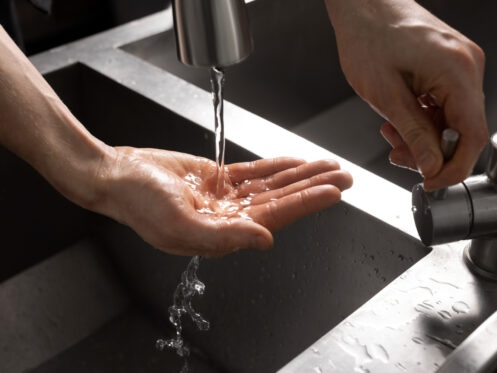Do you have low water pressure in your home? This common household issue can make daily tasks frustrating. Weak showers, slow-filling bathtubs, and inefficient appliances can all stem from insufficient water pressure.
You can increase your home’s water pressure without damaging your plumbing system by checking your main shutoff valve, testing current pressure levels with a gauge, cleaning mineral deposits from fixtures, and adjusting your pressure-reducing valve.
These simple fixes often solve the problem without calling a professional.
We recommend starting with the easiest solutions first. Sometimes low pressure happens because of partially closed valves or clogged aerators. Before making any major changes to your system, it’s important to understand your current pressure level and identify where the problem exists.
In this article, you’ll learn how to increase water pressure in your house safely and effectively without risking pipe damage.
Here’s what you need to know:
Let’s dive in!
What causes low water pressure in a house?
Low water pressure can turn simple tasks like showering or washing dishes into frustrating experiences. Several factors can reduce the water flow in your home, from issues within your plumbing system to problems with the municipal water supply.
Common culprits: Mineral buildup, valve issues, old pipes
Mineral buildup is one of the most common causes of low water pressure. Over time, minerals from hard water can accumulate inside pipes, creating a narrower pathway for water. This is especially problematic in older homes with galvanized steel pipes.
The U.S. Geological Survey explains that deposits of calcium carbonate and other minerals from hard water can narrow pipe interiors over time, reducing water flow and lowering pressure
Valve issues also frequently cause pressure problems. Your home has several water valves, including the main shutoff valve and individual fixture valves. If any of these aren’t fully open, they’ll restrict water flow. Check both the main water valve and fixture valves to ensure they’re completely open.
Old pipes can significantly impact water pressure. Corroded or damaged pipes restrict flow and may eventually leak. Homes with older plumbing systems often experience declining pressure as pipes deteriorate. Galvanized pipes are particularly prone to corrosion and narrowing over time.
City supply problems vs. internal plumbing issues
City supply problems affect entire neighborhoods. If your neighbors also have low pressure, the issue likely stems from the municipal water system. Contact your water provider to report the problem and ask if maintenance work is underway.
Internal plumbing issues only affect your home. These include cloggedpipes, malfunctioning pressure regulators, or leaks. A pressure regulator controls water flow into your home, and when it fails, pressure can drop significantly.
Water leaks drain pressure from your system. Even small leaks can cause noticeable pressure drops while wasting water and potentially damaging your home. Check for unexpected increases in your water bill or damp spots around your property.
How to spot localized vs whole-house low pressure
Localized pressure problems affect only certain fixtures. To identify these:
- Test multiple faucets throughout your home
- Compare upstairs and downstairs pressure
- Check both hot and cold water lines
If only one fixture has low pressure, the problem is likely with that fixture’s aerator or supply line. Remove and clean the aerator to remove any debris or mineral buildup.
Whole-house pressure issues affect all fixtures. This suggests a more systemic problem like:
- A partially closed main valve
- A failing pressure regulator
- Significant pipe corrosion or leaks
- Municipal supply problems
We can identify whole-house issues by testing multiple fixtures and comparing pressure at different times of day. Morning and evening typically show lower pressure during peak usage hours.
Safe ways to increase your home’s water pressure
Low water pressure can be frustrating, but there are several effective solutions that don’t require professional help. These methods are safe for your plumbing system and can often resolve the issue without expensive repairs.
Check and clean faucet aerators
faucet aerators are small mesh screens that screw onto the end of your faucets. They can become clogged with mineral deposits and debris over time, restricting water flow.
To clean them, unscrew the aerator from the faucet tip using pliers wrapped in cloth to avoid scratches. Soak the aerator in vinegar for about an hour to dissolve mineral buildup.
Use an old toothbrush to gently scrub away any remaining debris. Rinse thoroughly before reattaching.
This simple maintenance task should be done every few months, especially in areas with hard water. Clean aerators can dramatically improve water flow without changing your actual water pressure.
Inspect and adjust the pressure regulator
The pressure regulator controls water pressure entering your home. It’s typically located near your main water valve where the supply enters your house.
First, test your current pressure using a gauge attached to an outdoor spigot. Normal pressure ranges from 40-60 PSI. Anything below 40 indicates low pressure.
To adjust the regulator, locate the adjustment screw on top. Turn it clockwise in small increments to increase pressure. After each adjustment, check the pressure with your gauge.
Be careful not to exceed 60 PSI, as higher pressure can damage pipes and appliances. We recommend maintaining pressure between 50-60 PSI for optimal performance without risking your plumbing system.
The EPA’s WaterSense programadvises maintaining water pressure between 45–60 psi, stating that pressures above 80 psi can damage plumbing while pressures below this range may impair appliance function.
Advanced methods to improve water flow
When basic fixes don’t solve your water pressure problems, it’s time to explore more sophisticated approaches. These advanced methods can significantly improve water flow throughout your home while maintaining plumbing system integrity.
Look for Hidden Leaks Reducing System Efficiency
Hidden leaks are silent water pressure thieves that can go undetected for months. To find them, check your water meter, then avoid using water for two hours. If the meter changes during this time, you likely have a leak.
Common hiding spots for leaks include:
- Behind walls
- Under floors
- In crawl spaces
- Around pipe joints
- Near water heater connections
Even small leaks can reduce pressure throughout your entire system. A pinhole leak can waste up to 400 gallons per day!
Professional plumbers can use specialized equipment like acoustic leak detectors to pinpoint exact locations without damaging walls. Fixing these hidden leaks often restores pressure to normal levels without needing additional equipment.
When to consider a pressure-boosting pump
A pressure-boosting pump might be your best solution when:
- Your municipal water supply has inherently low pressure
- You live on a hill or at a high elevation
- You have a large home with multiple stories
- Your water must travel long distances through pipes
These pumps work by actively pushing water through your plumbing system with greater force. They typically cost between $300-$1,200 plus installation, depending on your home’s size and needs.
Installation should be handled by a professional plumber to ensure proper sizing and prevent damage to your pipes. We recommend pumps with built-in pressure regulators to prevent excessive pressure that could damage fixtures or pipes.
Remember to check if your local building codes require permits before installing a pressure-boosting system.
What not to do when fixing water pressure
When addressing water pressure issues, there are several approaches that can create more problems than they solve. Improper adjustments can lead to damaged pipes, leaks, or even catastrophic plumbing failures.
Why closing valves or adjusting pressure blindly is risky
Randomly adjusting valves or pressure regulators without understanding their function can cause serious problems. Many homeowners mistakenly close secondary valves partially to increase pressure in certain areas. This creates uneven water distribution and puts strain on your plumbing system.
The pressure reducing valve (PRV) shouldn’t be adjusted without first measuring your current PSI. We recommend using a water pressure gauge attached to an outdoorspigot to get an accurate reading before making any changes.
Neverturn your PRV to maximum pressure without knowing your pipes’ capacity. Most residential plumbing systems are designed to handle between 40-60 PSI. Anything higher requires professional assessment.
Potential damage from over-pressurization
Over-pressurization is one of the most common causes of plumbing damage. When water pressure exceeds safe levels (typically above 80 PSI), it puts tremendous strain on pipes, fittings, and appliances.
High PSI can cause:
- Pipe bursting or leaking at joints
- Damaged water heater tanks
- Premature failure of washing machines and dishwashers
- Chronic leaky faucets
- Excessive water hammer (banging pipes)
We’ve seen cases where homeowners increased pressure to improve shower flow, only to cause pinhole leaks throughout their home. These small leaks often go unnoticed until significant water damage occurs.
The repair costs from over-pressurization typically far exceed the cost of proper pressure solutions like booster pumps or professional PRV adjustments.
Signs your plumbing can’t handle higher PSI
Not all plumbing systems can safely handle increased pressure. Older homes with galvanized or copper pipes may have weakened areas from years of use and corrosion.
Warning signs your system can’t handle higher pressure:
- Pipes that vibrate or make noise when water is running
- Small leaks developing around fittings after pressure adjustments
- Discolored water indicating pipe corrosion
- Multiple appliance failures in a short timeframe
If your home has pipes over 20 years old, we strongly recommend having a plumber inspect before increasing pressure. Homes with plastic PEX plumbing generally handle pressure better than older materials, but still have limitations.
Always start with the least invasive solutions, like cleaning aerators and showerheads, before attempting to increase your system’s PSI.
Professional solutions for lasting results
While DIY fixes can temporarily improve water pressure, professional plumbers offer long-term solutions using specialized knowledge and equipment. They can identify root causes that homeowners might miss and implement lasting improvements.
Accurate pressure diagnosis with specialized tools
Professional plumbers use pressure gauges and flow meters to precisely measure your home’s water pressure. These readings reveal exactly what’s happening throughout your plumbing system. Many professionals also employ video inspection cameras to examine pipes from the inside, identifying hidden blockagesor damage.
Water pressure testing kits used by pros can detect pressure variations between different areas of your home. This helps pinpoint exactly where problems originate.
Some plumbers now use ultrasonic leak detectors that can find hidden water leaks inside walls without causing damage. These tools allow them to create a comprehensive pressure map of your entire system.
Professional diagnosis prevents wasting money on unnecessary repairs or upgrades by identifying the true source of your pressure problems.
Solutions for homes with old pipes or complex layouts
Older homes often have galvanized steel pipes that corrode internally, reducing water flow dramatically. Professional plumbers can selectively replace these problem sections rather than overhauling your entire system.
For complex plumbing layouts, pros might recommend installing a manifold system. This creates more direct water pathways to fixtures, reducing pressure loss through twists and turns.
In multi-story homes, professionals can install pressure-balancing valves that ensure consistent water pressure across different floor levels. This prevents pressure drops in upper-floor bathrooms.
For homes with extremely old plumbing, a plumber might suggest strategic pipe replacements with PEX or copper. These materials maintain better flow rates and resist corrosion.
Preventing long-term plumbing damage through smart upgrades
Professionals can install pressure regulating valves that maintain optimal pressure levels automatically. This prevents damage from pressure fluctuations while ensuring good flow.
Water softeners installed by pros reduce mineral buildup inside pipes and appliances. This prevents the gradual narrowing of pipes that leads to pressure loss over time.
For comprehensive protection, plumbers might recommend installing a whole-house filtration system. These systems remove sediment before it enters your plumbing, preventing clogs throughout your home.
Smart pressure monitoring systems can be installed to alert you to sudden changes in water pressure. These early warnings help prevent damage from developing problems.
Professionals can also perform yearly maintenance checks to catch minor issues before they affect water pressure. This proactive approach extends the life of your entire plumbing system.
Key takeaways for boosting home water pressure safelyConclusion
Improving water pressure in your home doesn’t have to be complicated or expensive. By checking for common issues like clogged aerators and leaky pipes, you can often solve the problem yourself.
For more persistent issues, adjusting your pressure regulator can make a big difference. Remember to test your pressure with a gauge first and make small adjustments.
Installing a water pressure booster pump is a more significant investment but can be worth it for homes with chronically low pressure.
Regular maintenance of your plumbing system helps prevent pressure problems before they start. Clean fixtures, check for leaks, and ensure valves are fully open.
We recommend starting with the simplest solutions first. If DIY methods don’t work, don’t hesitate to call a professional plumber who can diagnose more complex issues.
The ideal water pressure range is 40-60 PSI. Going higher may damage your pipes and fixtures, while lower pressure makes everyday tasks frustrating.
With these tips, you can enjoy better water pressure while still protecting your plumbing system for years to come.
If you’re struggling with low water pressure, contact Splash Plumbing todayfor expert diagnosis and safe pressure solutions












